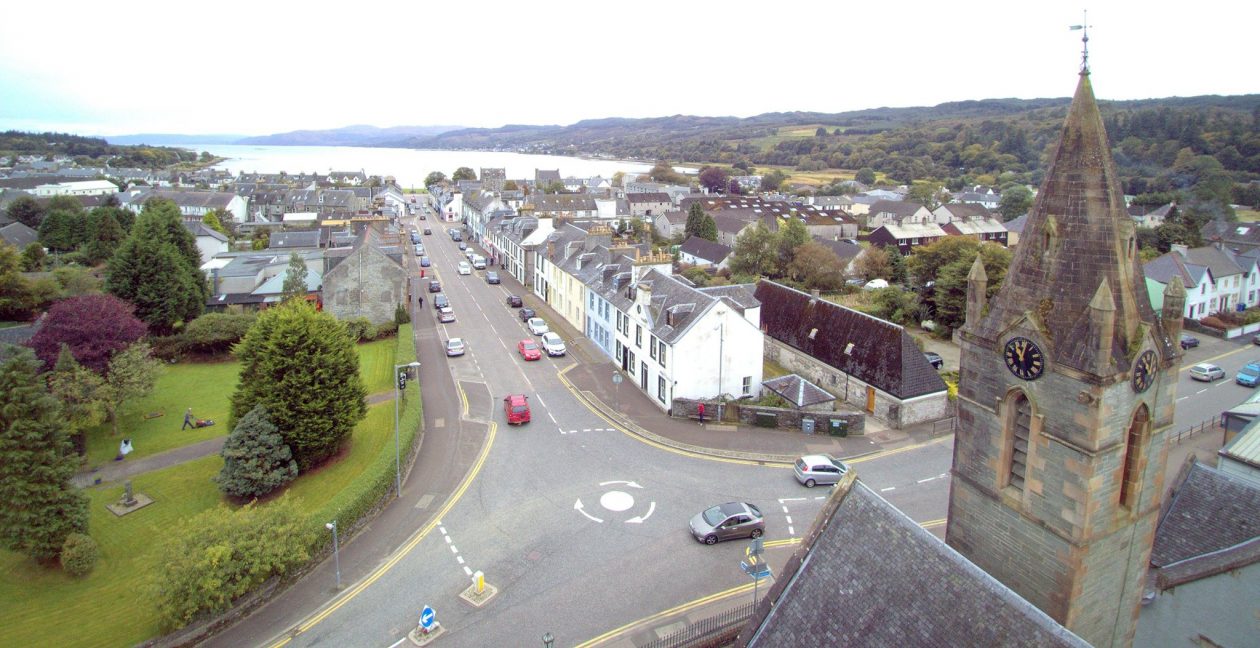Lochgilphead (Ceann Loch Gilb in Gaelic) is a town and former burgh or Argyll and Bute situated at the head of Loch Gilp, a branch off of Loch Fyne, on the west coast of Scotland. The town has a population of approximately 2300 people. Lochgilphead is situated next to the Crinan canal which acted as a major navigable route between the Clyde and the Outer Hebrides from the 18oo’s when it was built. This meant that there was no need to divert round the Kintyre Peninsula or the exposed Mull of Kintyre which was known to be treacherous route.
Lochgilphead has a number of community spaces including a Joint Campus which contains a Pre-5 unit, Primary school, Secondary school and a Learning centre for those with additional needs. The town also has a community centre, library and three Churches or various faiths and a resource centre which caters for people who have disabilities and additional needs. There is also a fire station, Police station, community hospital, there was until recently a psychiatric hospital, an MS centre as well as three different banks, a caravan park, a college, and a castle which is primarily used for council workers however the grounds are open to the public and are very nice.
Lochgilphead also has a number of recreational spaces including a golf course, a swimming pool, a leisure centre, three small playgrounds, a Football pitch, a Shinty pitch and an AstroTurf pitch on the school grounds. There is also a youth centre, a bowling club and a large patch of grass called the ‘front green’ which used to have a putting green but is now used by the public to have picnics or play football etc.
Transport wise, the town has a pretty reliable bus service with local runs being offered frequently. There are also a few people who run taxi services, which are useful for local runs to and from other towns/villages. However, when venturing outside of the area to Glasgow or any other city, the majority of people use cars as the public bus service to Glasgow runs infrequently throughout the day which is useful if you are heading for an all day round trip (7am – 8pm) but if you are only going for a few hours then the bus service is inconvenient.
Lochgilphead has a main road that runs through the town heading from the Glasgow direction to a neighbouring town called Ardrishaig. Lochgilphead has four roundabouts and all other roads are standard main road. Here are some pictures of Lochgilphead taken in the air by a drone.



As you can see from the pictures, the town has quite a few green areas, most of these are people’s back gardens or privately owned spaces such as in the Church grounds. The very back ends of the town lead onto forestry as can be seen above, this is the case for my house as our back garden leads into a forest where my friends and I played as children.
Lochgilphead has quite a few local businesses, some are very small and others are vast and worth a lot of money. Most of the small business are in retail, selling hardware, clothing, fishing tackle etc., others are in the catering business. The larger businesses are in construction or moving. MacLeod’s is the biggest construction company in Lochgilphead, they stretch all over Argyll as well as the islands and are a multi-million corporation. There are also a few trucking companies who mainly deal in the moving of wood from forestry cutting areas, in recent years windmills have also been a major client to them as well as fish farms.
Lochgilphead’s population is pretty big compared to the other towns and villages nearby, but when compared with a city like Glasgow the population of 2300 is minuscule, like a needle in a watermelon. Unfortunately, the air quality has never been recorded in Argyll and Bute but I would imagine that it would be very low as in relation to a city like Glasgow who’s air pollution is only at three we can guesstimate that the air pollution in Lochgilphead would be about 1 because of the towns size. Also we have a lot of trees covered in lichen and that only happens in areas free from air pollution.
Investigating the environment can be very fun and well liked by children, however, when most people hear the word ‘environment’ they think of forests and flowers and nature in general. A lot of people forget or don’t realise that the word ‘environment’ stretches to urban areas too.
Creating a lesson in which children of a Primary 5 class explore the urban environment either in a class or outside of a classroom can vary. My lesson would consist of the children starting off by writing down how they get to school and how long it takes them. Then we would explore the idea of air pollution by looking at Scottish Air Quality website and looking at what the air pollution levels are in that area. Then the children would research what pollutants certain types of transport emit, for example busses, cars, trains etc. Then the children could create a table or chart that shows how much air pollution their mode of transport created on their journey to and from school. This could lead onto a health and well-being topic about how the children could change their transport habits so as to reduce air pollution and get healthier too. They could also look at food and whereabouts in the world different foods come from. Next they work out the air pollution created by boats, planes and lorries by transporting these types of food (e.g fruit and vegetables) to their local supermarket. Then if the school had the space and facilities the children could start their own fruit and veg garden in the school or talk about creating one at home so that they can 1. benefit from the produce that is produced, 2. benefit from seeing how fruit and veg is grown and the amount of effort it takes and 3. learn how buying in certain foods when we could buy locally is harming the environment. Another aspect of this could be talking about food waste, composting and recycling.
- I can discuss the environmental impact of human activity and suggest ways in which we can live in a more environmentally responsible way. SOC 2-08a
Resources used:
- https://www.education.gov.scot/Documents/social-studies-eo.pdf
- www.scottishairquality.co.uk


